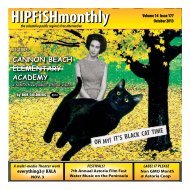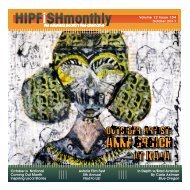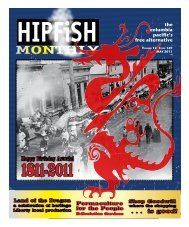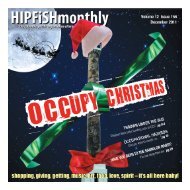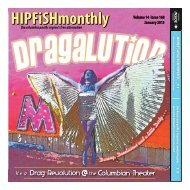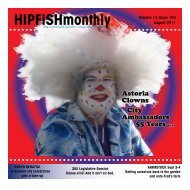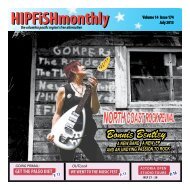KALA - HIPFiSHmonthly
KALA - HIPFiSHmonthly
KALA - HIPFiSHmonthly
- No tags were found...
Create successful ePaper yourself
Turn your PDF publications into a flip-book with our unique Google optimized e-Paper software.
continued from page 12projects around the Astoria area. Afteremploying neighbors to help buildhis house, which fits in well with theVictorian/Craftsman architecture ofthe neighborhood, Kennedy has donemany cabinet and other woodworkinstallations around town in betweenbigger projects. He currently has ahouse he designed and built for saleat 10th and Grand in Astoria. (Checkout his web site at http://www.blindmoseswoodworking.com/for detailsif you’re interested.) The recessionhas made homebuilding tough, butBlind Moses is nonetheless doingOK. Kennedy showed me plans andprototypes for a springy bench at hisshop, and he’s always thinking of newideas to try.Kennedy’s latest big project wasthe repurposing of the old Lovell Autobuilding and the construction of anoutdoor patio to the Fort George restaurantand various other upgrades tothe Fort George block, now owned byJack Harris and Chris Nemlowill. Thecanning operationand new tap roomin the Lovell buildingwere great examplesof “learning on thejob” and “gettingthe job done,” Kennedytold me. Givena tight budget anda lot of leeway, heworked with ownersJack Harris andChris Nemlowill andmany others to createAstoria’s latestindustrial enterprise.Kennedy has aknack for findingmaterials that canbe repurposed in hisprojects. Some ofthe ceiling beamsin his house arefrom pilings from oldcanneries in the Astoriaarea. The FortGeorge project usedtimbers from thebuilding at 10th andCommercial that burned on Thanksgivingnight in 2008 in the outdoorpatio railings, “the world’s most elaborategarbage shed” doors, and mostimpressively, in the new tap room inthe Lovell building. “I found them (30twenty-foot timbers) laying in a pile,”said Kennedy, who was tipped off byMitch Mitchum, the owner of the nowhistorically-renovated building.Harris and Nemlowill acquired a 30barrel brewhouse from Saint ArnoldBrewing Company of Houston, Texas,and purchased a state of the artcanning operation from Cask BrewingSystems in Calgary, Canada earlierthis year. Kennedy’s job was to makeit all work, and that required learninga lot about brewing. That’s been atheme for him throughout his career.”The walls of the canning area aremade of corrugated metal, that wasused in the painting of the Astoria-Megler Bridge. They give the placesome industrial warehouse character,and the price was right. Coppertubing from the brewing equipmentbecame handrails. In the large coolerthat keeps the canned beer cold andready to distribute, Kennedy usedmetal panels that also came with thebrewing equipment. This cooler wasoffice space when the building was anauto shop.During the 7-month project, Kennedylearned all about not only brewingbeer, but also about the historyof the Lovell Building from the Lovellfamily and friends. The building usedto house 12 businesses, including amovie theater on the upper floor. Theowners haven’t yet decided what toRe-purposed copper and steeldo with the parts of the building notbeing used for canning, but Kennedythinks the second floor should sport aroller derby arena. “Wouldn’t that becool!” he exclaimed.The tour ended with a visit to thebathrooms, which are vintage. ButKennedy’s proudest achievement onthe project? “You’ve got to see thepig,” he pleaded. “My artistic contributionto the operation!” Yes, thereit was, a barley storage tank with anattitude. The best touch is the groundwire that was fashioned into a pigtail.Not only does Kennedy get the jobdone, he has fun doing it!Bright blue and silver cans of 1811 Lager, and the beautiful,magical spinning hop of the Vortex IPA (both designed byJosh Berger of id branding and longtime friend of Jack Harris)are now showcased at Fred Meyer in Warrenton. A long,tall cooler stacked with fresh FGB beer is ready to quench asummer’s thirst.The question arises; with all this expansion is the wonderduo of Harris and Nemlowill ready to overtake craft brew inAmerica?“We want to get beer to everybody in Oregon who wantsit -- hopefully to the Seattle area by next summer. We haveestablishments calling from Seattle, “What do I have to doto get your beer? We can’t make enough right now to fillorders,” says Nemlowill.Increasing production and filling more orders is a matter ofthe fermentation process. Nemlowill informs that two morefermentors are in the works. “This size brewery is perfect. It isbig enough so that you get enough consistency in your beer,and its not so big that your beer losses its character. “But the 50 states are not in these brew masters manufacturingprojection.“It doesn’t make sense to ship water. It’s not good for theenvironment for people to ship water all over the United States.Why steep your tea on the west coast and ship it to the east coast?Steep your tea where you are going to drink it. As long as we cankeep the quality high on our product, this is the criteria for shipping.”Harris and Nemlowill are also setting a new precedent. Theywant to keep their product regional, based on what they are creating.That precedent is one they are making in the Oregon craft brewThe Tap Room, Lovell Building. OPen Fri 3-8pm, Sat 1-8pm, SunNonn-5pm. Enter through the Fort George Parking Lot, or 14thStreet.Brewery Tours: Saturday and Sundays @ 1pm & 4pm25 cans per minute, fresh from the tank.community. Cans of FGB, must be kept cold, never warm-stored,and must be sold within 60 days of delivery. It is not a safetyprecaution – it’s a quality requirement. Craft brew after 60 days, isnot the brew they painstakingly craft to stimulate the beer lover’ssenses. FGB just invested in a very expensive can labeler, whichputs the quality date on the bottom of the can. Cans of 1811 lagerand Vortex IPA are the only beers sitting in the back storage dairycooler in grocery stores about Oregon. Serious passion.“We believe in our beer – we know how much work we put into it– we know the quality of the ingredients. We want people to experiencethis,” states Nemlowill resolutely. “We pull the beer if it’s pastthe date. Then it goes into the black box.”Tim Ensign, is FBG’s top dog sales rep, whose beer career coversthe gamut, from working for Sierra Nevada Bottling, to TraderJoes, and large beer distribution companies. Even Ensign at firstwas dubious as to how retailers would respond to this very uniquepolicy, but customer by customer, Nemlowill states, “It’s creatingdistributors who are beginning to appreciate the quality edge.”“I feel lucky to go out and sell something that is higher qualitythan what anybody else can sell to that customer. It feels good tohave that competitive advantage. It is also a competitive edge forour customers. “Nemlowill is an advocate for more people doing small manufacturingin Astoria, and he says, “It’s the best way to have completecontrol over your products.” And local jobs are a cherished andever-valued commodity.If part of your product is serving the public, Fort George is nowslouch at that either. The public house is jammed to the brim anygiven night of the week. The service is amazingly good in a packed,music-filled, lively house. Young, hipster waiters don’t flinch at acrabby customer, whom may peruse what’s on tap or take in thegorgeous chalk art on not one, but two expansive boards createdby a bevy of coastal artists.Beer in a can is what you get on draft – basically a keg is justa big can, giving the consumer the freshest, most pure brew possible.And cans, as opposed to bottles, protect beer from light andoxygen. Cans are airtight and oxygen-free. When light consistentlyhits a bottle of beer, it can turn skunky and ultimately undrinkable.Yuck. Cans too, are more easily recyclable.The canning of the two brews is the current ticket, but Nemlowillsays, eventually they’ll be looking at several more styles to add tothe canning line in the future, this with the inclusion of seasonalspecialties. They also love to hear from customers as to what theymay want to have in the can.While the can played a huge role in the economy and history ofAstoria, as commercial canners were mad to get rich on shippingsalmon and tuna to the demanding consumer public, it also playeda part in depleting the resources. This can renaissance has a newvalue structure. We “can” romanticize and celebrate history, but ifwe pay attention, a new kind of prosperity is on the horizon. Thriveon Fort George. Lets tip up our cans and drink to that!Every SUNDAY LIVE MUSICWhen Fort George started the LIVE music on Sundays, part of the missionwas to provide entertainment on an otherwise usual slow night. Not competingwith other venues. Seemed an improbable audience.Who would have thought that people, really needing to get out of the house,now just bring their kids with them for a beer and to end the weekend.So Don’t Miss Atomic Duo from Austin TX, fronted by Bad Livers originatorMark Rubin, July 24. 8pm, No Cover.july11 hipfishmonthly.com14



